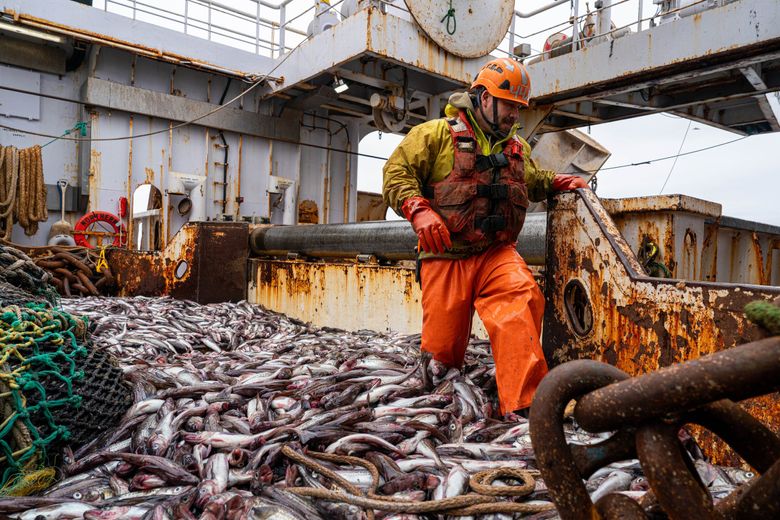
ABOARD THE NORTHERN HAWK, Bering Sea — Some 400 miles northwest of Dutch Harbor, Bering Sea pollock congregated in spectacular fashion.
In the wheelhouse of this factory trawler, Captain Jim Egaas scanned a sonar displaying a dense red band that represented millions of fish in a school stretching for miles.
He could see the pollock up close on another screen that relayed images from an undersea camera stitched in the mesh of a quarter-mile-long net. The video feed showed swarms of them deep in the funnel-shaped trap.
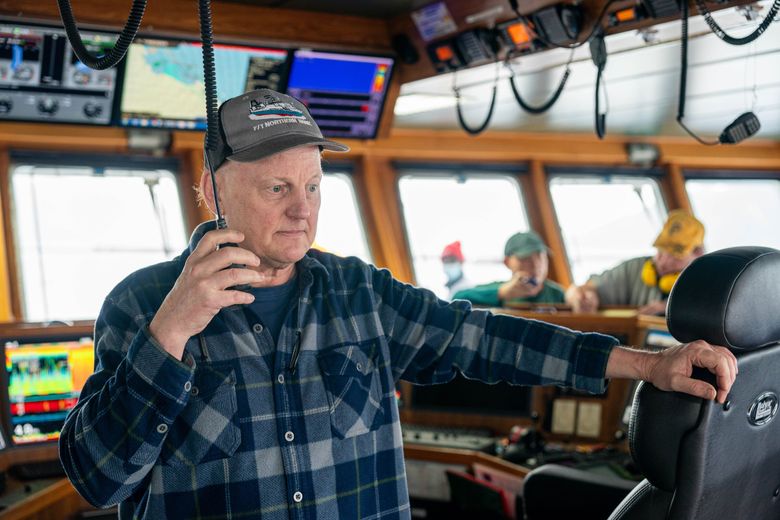
Once pulled on board, the tail end of the net bulged with more than 220,000 pounds of tightly packed pollock. A crew member unstitched a seam. Raised by a powerful winch, the net spewed a silver avalanche of fish into below-deck holding tanks to await processing in a plant primed to operate 24 hours a day.
Egaas was in hurry-up mode. Even before the last of this catch was shaken from the webbing, he called for crew members to unfurl a second net from a giant reel.
“I like what we are seeing. We’re on the stock,” Egaas said.
The Northern Hawk is owned by Coastal Villages Region Fund, which uses revenue generated from this formidable trawl operation to help support 20 largely Yup’ik communities in the Kuskokwim River region of southwest Alaska, where subsistence is a mainstay of the culture.
Coastal Villages is one of six western Alaska nonprofits forged by a series of federal actions — initially launched 32 years ago — that wrested control of some Bering Sea fishery allocations from largely Seattle-based fleets.

Today, these groups, with boards of directors drawn from the western Alaska villages they serve, collectively control lucrative catch rights to more than 35% of Bering Sea pollock. This gives them a big stake in the largest-volume seafood harvest in North America, which in 2022 yielded more than 2.4 billion pounds of pollock for products that are mainstays of U.S. and international seafood markets, including McDonald’s fish sandwiches.
Their growing clout in the North Pacific fishing industry comes at a time of increased scrutiny of trawling’s impacts in a Bering Sea rocked by marine heat waves. National Marine Fisheries Service scientists have linked the warmer waters to the implosion of snow crab populations and dramatic declines in chum salmon returns to western Alaska.
A federal lawsuit filed this year by two Alaska tribal organizations — the Association of Village Council Presidents and Tanana Chiefs Conference — seeks a court order to force federal regulators to reassess pollock harvest levels.
The plaintiffs note the pollock nets, which often touch bottom, may harm crabs and other sea life and also cite the trawlers’ incidental take of salmon.
The lawsuit is opposed by the At-Sea Processors Association, a group that includes Coastal Villages and had intervened in the case on the side of the federal government.
“We felt compelled to do it. We don’t have any negative feelings towards them. But we think it’s kind of a misguided effort,” said Eric Deakin, Coastal Villages CEO, who works out of an Anchorage headquarters office.
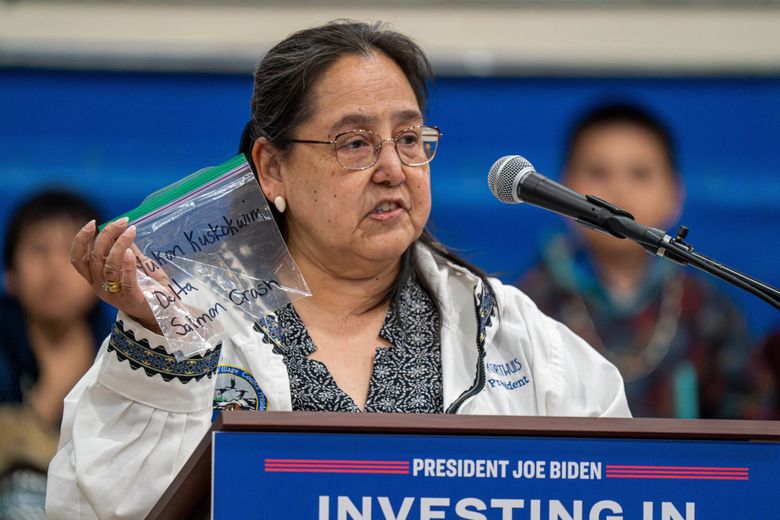
Yukon-Kuskokwim tribal leaders also have pushed for more action to sharply restrict the trawl take of western Alaska chum from the North Pacific Fishery Management Council, composed of federal, state and industry officials who help set harvest rules. This would be coupled with a federal rule already in place that limits the pollock fleets’ take of Chinook.
For the trawl fleet, salmon are considered a prohibited species that cannot be marketed.
At an October meeting, the council backed a motion to study a range of options to limit the pollock fleet’s chum catch. The council did not include some of the lower limits that western Alaska tribal representatives wanted to be considered.
“The salmon crash … really galvanized our tribes,” said Vivian Korthuis, executive director of the Association of Village Council Presidents, which represents 56 federally recognized tribes in the Yukon-Kuskokwim Delta region of western Alaska. “We cannot address this crisis ourselves. We have many partners that we are working with. We meet on a regular basis and are trying to figure out the best way forward.”
The tribes have received a boost from Alaska U.S. Rep. Mary Peltola, who formerly served as executive director of the Bethel-based Kuskokwim River Intertribal Fish Commission and made Bering Sea fisheries management a high-profile issue in her 2022 congressional campaign.
“The status quo is failing Alaskans. I do not believe industrial trawling is sustainable, especially during such low ocean productivity,” she declared in a 2022 campaign statement.
The tribes also have drawn support from crabbers battered by depressed snow and red king crab stocks that scuttled harvest seasons, as well environmentalists and some other Alaska commercial and sport fishers, along with ocean conservation organizations that have ramped up criticism of the trawl fleets.
A Facebook group, STOP Alaskan Trawler Bycatch, has more than 26,000 members and has helped stoke a broader campaign against trawl bycatch — the incidental take of marine species.
For the pollock fleet, the incidental take ranges from halibut, herring and arrowtooth flounder to more than 50 metric tons of sharks netted in 2022. This bycatch represents less than 1% of the catch, which NOAA Fisheries considers a “very low” rate, according to an agency statement.
In decades past, pollock trawlers on rare occasions had fatal entanglements with orcas. From 1991 to 2003, five were killed by encounters with this gear, according to a review of fishery observer records published in a National Marine Fisheries Service journal.
Pollock industry officials said their fleet did not bring on board any of the 10 orcas — nine of which died — that NOAA Fisheries reported got caught in trawl nets this year.
NOAA Fisheries later updated that report to indicate that one of the whales was caught in the type of net used by pollock boats.
A representative of the At-Sea Processors Association, Stephanie Madsen, said that one orca was caught in a factory trawler net in September but not brought onboard the vessel. It was documented by an observer. The whale was decomposing and appeared to have been dead for some time, she said.
Other orcas were caught by another type of trawl net used by a different fishing fleet that targets turbot and other bottom-dwelling fish.
“I have never, never caught an orca, and I was kind of surprised that the flatfish guys did,” Egaas said.
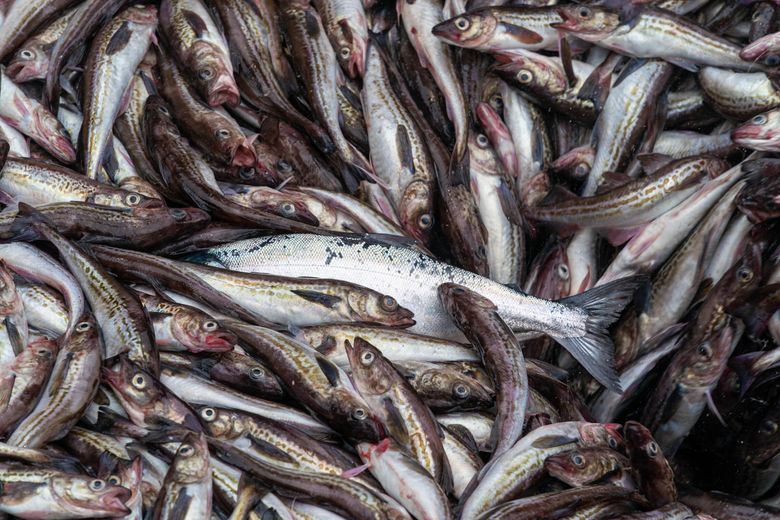
Tribal backlash
Salmon is a key food source for western Alaska communities because it’s critical to Indigenous cultures and village economies. The tribal backlash against the pollock fleet gained momentum in 2021 when the chum runs collapsed in the Yukon-Kuskokwim Delta drainages, choking off subsistence harvests as well as any hope for commercial catches in a region that includes villages with some of the highest poverty rates in Alaska.
That same year, the trawl take of chum exceeded 540,000 fish — the highest level in more than a decade.
Russia has greatly ramped up hatchery production of chum that migrate to the Bering Sea and mingle with North America-born wild stocks. Genetic testing by the National Marine Fisheries Service concluded that more than half of the chum caught in trawl nets were from freshwater drainages in Northeast Asia.
“It’s frustrating because there are a lot more foreign hatchery fish being released than there used to be,” said Deakin, Coastal Villages chief executive. “There’s a lot of competition for food out there.”
Still, in 2021 and again in 2022, more than 50,000 chum caught by the pollock fleet were estimated to be wild fish born in and eventually bound for western Alaska drainages.
A state biologist, Katie Howard, says the trawl fleet’s chum bycatch is believed to have a low impact on returns to western Alaska drainages. She estimated it would have reduced run sizes by well under 10% but said an updated analysis needs to be done.
The trawl bycatch numbers continue to spark outrage in western Alaska.
In a listening session Peltola held this spring in Anchorage, villagers voiced their anger with the trawlers’ take of chum.
“There was no fishing in the Yukon. The Kuskokwim was shut,” said Mike Williams Sr., a tribal leader from Akiak. “Families are suffering. So where is the balance? … Let’s equalize the playing field.”
In 2023, western Alaska Chinook stocks remained very weak. Chum returns improved substantially but remained well below long-term averages, according to Alaska Department of Fish and Game biologists.
The number of Kuskokwim chum that made it past an in-river sonar jumped more than ninefold this year compared with 2021. Communities that fish also benefited from a big sockeye run. But on the Yukon River, subsistence harvests for summer chum remained low, and the fall run was too weak to allow any targeted catch.
In the Bering Sea, pollock skippers scrambled to avoid chum during late summer, when their encounters with these fish are most frequent. They were quick to share information with one another about salmon hot spots.
“The behavior of the fleet is markedly different this year,’’ said Steve Martell, a data and policy analyst with Sea State, which monitors the fleet’s catch and has the power, under cooperative agreements, to put harvest restrictions in areas where lots of chum are found.
By September, as the 2023 pollock season was winding down, the fleet’s chum count was down 80% from the 2021 take.
Coastal Villages has board members in villages hard hit by the salmon declines. The crew of the Northern Hawk has been under orders to move away from areas of high salmon bycatch even when they yield big pollock that produce the most profitable products.
“It takes time and money. And not everybody’s willing to do that,” Deakin said. “There’s no secret sauce.”
Still, the Hawk’s skipper, Egaas, has found that reducing the chum catch can be challenging.
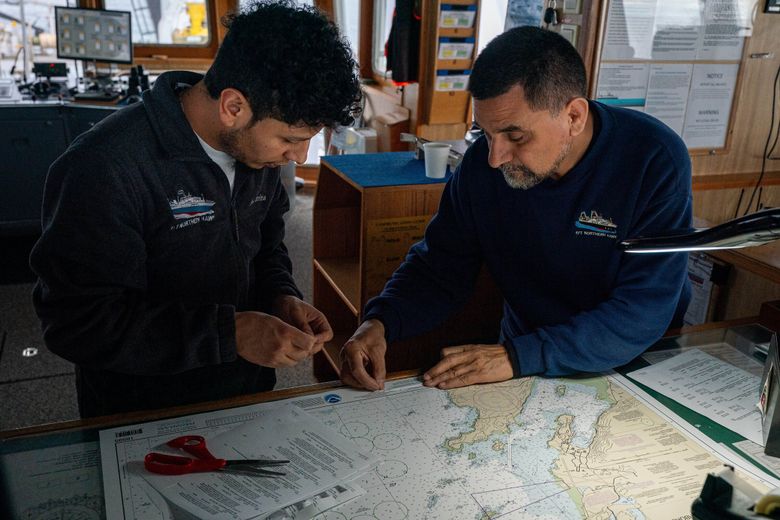
The salmon often can be found at the same depth and locations as pollock and appear to be more numerous in years when bottom temperatures are warmer. Sometimes, when he moves away from chum, Egaas drops a net in an area where he catches even more or finds a scarcity of pollock.
To complicate things further, other fish also should be avoided — such as herring — and that effort can push boats into an area with more chum.
In 2021, despite Egaas’ best efforts to steer clear of salmon, the Northern Hawk caught more than 7,800 chum. In 2022, his efforts were more successful, and the vessel’s chum take plummeted to fewer than 320 fish, according to a report compiled by a factory trawler cooperative.
Egaas, 62, is tall and lanky. He grew up in Ballard and joined the Alaska trawl fisheries after high school. In bluejeans and a flannel shirt, he paces around the perimeter of the wheelhouse to help keep his weight under control. Sometimes, when it’s not too rough, he jumps onto a treadmill.
He keeps an eye on the chum count from each tow of the net. All of these salmon are placed in an aluminum bin under 24-hour camera surveillance until counted by a federally contracted observer.
“None of us want to catch them. We understand the pressure that the board members are getting from the guys in the village that aren’t able to fish,” Egaas said. “We proved we can do better, and we need to.”
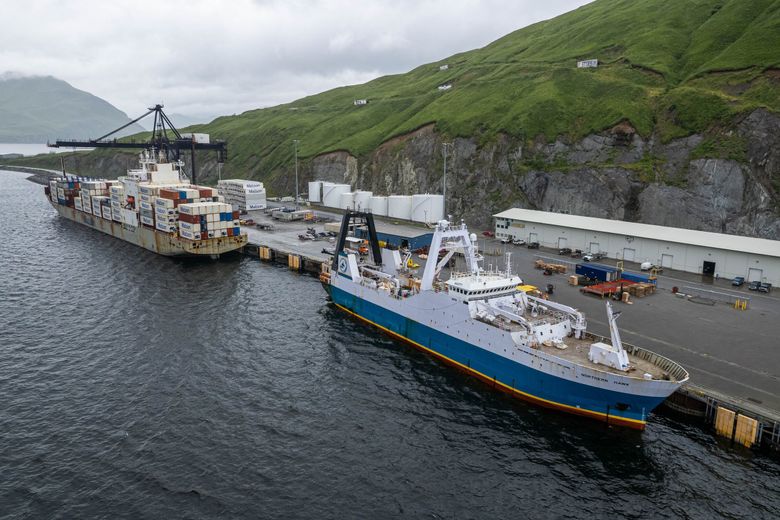
A powerful industry player
In early August, the Northern Hawk moored at a Dutch Harbor dock as 129 crew members prepared for one last push for pollock in the 2023 summer harvest season.
To maintain operations, the 341-foot vessel can produce 600 metric tons of fresh water each day through a membrane process that separates the salt from the Bering Sea. Incinerators have been installed to burn trash. Two 4,500-horsepower diesel engines drive the propulsion system. They also make it possible to generate electricity to run the below-deck fish factory and compress the Freon gas needed to freeze millions of pounds of pollock.
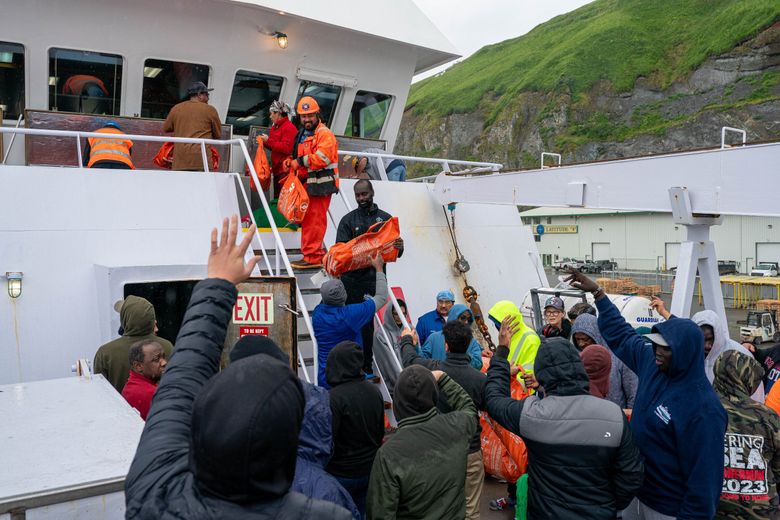
At the port, the crew unloaded boxes of those fish from a frigid cargo hold on a just-completed fishing trip, piling them onto a conveyor while a crane moved packaging and other supplies onto the vessel for the next sea journey.
“It’s an interesting operation. A lot of people say a lot of bad things about these boats,” Egaas said. “They are actually the most efficient fishing vessels in the fleet.”
Coastal Villages initially was a part-owner of the Northern Hawk through an investment in American Seafoods, a Seattle-based fishing company that operates the nation’s biggest factory trawler fleet.
But there was friction in this partnership.
Bernt Bodal, who served as president of American Seafoods, flew a private jet and enjoyed corporate yachting, all of which ate up revenue that Coastal Villages executives say they would have preferred to invest in western Alaska.
“They bought not just one jet but two,” said Deakin, Coastal Villages CEO. “There was a big fight until we got out.”
In 2010, Coastal Villages split with American Seafoods. The Alaska nonprofit took the Northern Hawk, along with some pollock quota, as part of the compensation for its ownership stake.
Amid the split, Coastal Villages had its own spending controversies.
Morgen Crow, then the group’s executive director, drew $832,367 in salary and other compensation in 2010. Critics said that payday gave new meaning to the term “pollock provides,” a slogan Coastal Villages long has used to promote the benefits of the trawl fishery to western Alaska communities.
Crow’s compensation rose to more than $1 million in 2020, according to an Internal Revenue Service filing, even as he retired midyear.
Deakin, the current Coastal Villages executive director, last year was paid $446,662 in salaries and bonuses. Deakin said his salary was settled on by board members, who wanted to recalibrate the compensation.
Coastal Villages’ acquisition of the Northern Hawk marked the first, and so far the only, time that one of the six western Alaska nonprofits — known as Community Development Quota or CDQ groups — would take full ownership control of a pollock factory trawler.
Coastal Villages invested more than $3 million in an electric winch system and new equipment for surimi, a fish paste used to make products such as imitation crab. Other improvements include Starlink satellite Wi-Fi that offers the crew the opportunity to video chat with family or even stream movies in their bunks.
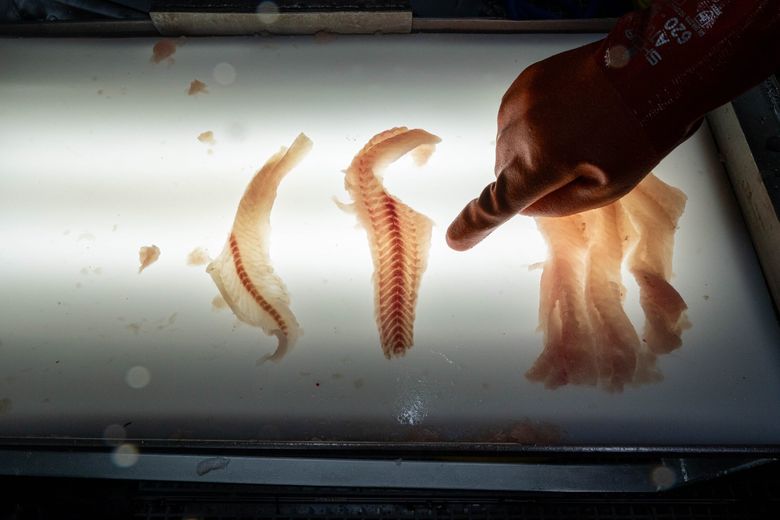
“It’s a good platform. They have given us pretty much everything we’ve asked for,” said Tom Hindermann, the Northern Hawk’s chief engineer. “They’re going strong and just keep getting bigger.”
Coastal Villages has been on the leading edge of a broader shift in the North Pacific seafood industry as the Alaska groups expand ownership stakes in old-line Washington fishing operations.
In 2011, Coastal Villages, in a partnership with Norton Sound Economic Development Corp. and the Japanese seafood giant Maruha Nichiro, purchased five pollock boats, along with the quota that allowed them to deliver to a shore-based plant in Unalaska.
Last year, Coastal Villages and Norton Sound, in another joint venture with Maruha, acquired nine more pollock boats delivering to a shore-side processor. Coastal Villages also acquired a 17,100-square-foot Seattle operations hub on a nearly 7-acre tract along Lake Union.
These investments have made Coastal Villages an increasingly powerful player in the seafood industry. Revenue before expenses topped $88 million in 2022, according to an annual report. Earlier this year, Coastal Villages Vice President Rudy Tsukada was chosen for a seat on the North Pacific Fishery Management Council by Alaska Gov. Mike Dunleavy, a move that disappointed tribal groups who had requested he name one of their representatives.
During the first week of August, just before the Northern Hawk’s final summer pollock trip, representatives of two big pollock customers — Gorton’s Seafood and McDonald’s — checked out the boat in Dutch Harbor.
In Anchorage, Deakin dined at the Hotel Captain Cook’s Crow’s Nest with the president of Maruha, who was en route to check on Aleutian Islands processing operations.
“We’ve had a very profitable business with them. … They like what’s going on,” Deakin said.
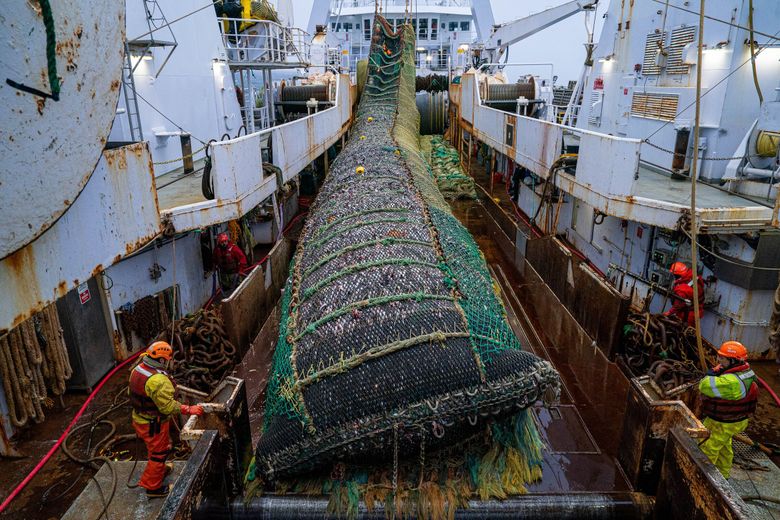
Processing around the clock
After leaving Dutch Harbor, the Northern Hawk encountered modest swells on a daylong cruise past the Pribilof Islands to the fishing grounds. Then, at 1:30 on a Sunday morning, a rumbling conveyor belt started moving pollock through the below-deck factory. Some 40 crew donned rubber gloves and rain gear and took their positions in a low-ceilinged maze of stainless-steel conveyors and sharp-bladed machines able to head, gut and fillet 180 pollock per minute.
Many are immigrants. Their home countries include more than a dozen African nations as well as the Philippines, Mexico and Vietnam.
They work in often cramped duty stations, wearing earmuffs to reduce the din of the machinery as well as masks or bandannas to ease the fish smells. They perform vital but often endlessly repetitive tasks. Some arrange pollock so they feed properly into the filleting machine, a task that requires both hands in constant motion. Others break out blocks of frozen fish from aluminum trays so they can be packaged in cardboard boxes.
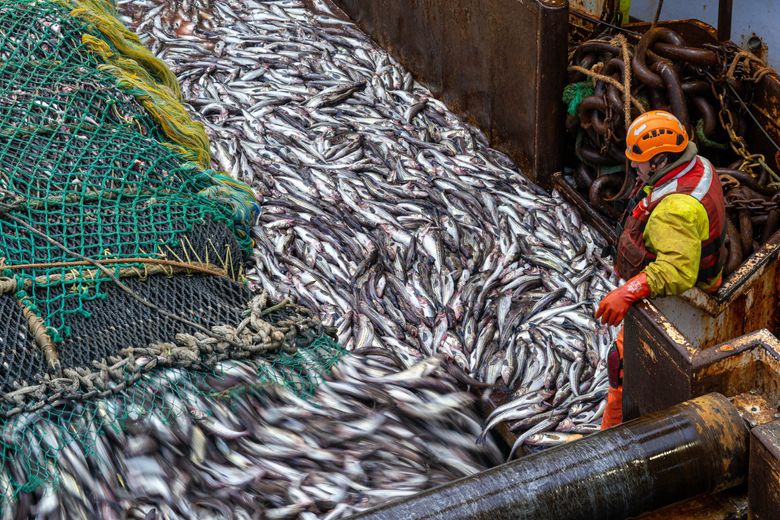
The processing crew needs to work quickly. Each time the net comes aboard the ship, all that fresh-caught fish must be processed within 12 hours, preferably considerably less time, to maintain the quality of the frozen product.
“You don’t have no holiday. No Sunday. If you go to the bathroom, you have to go fast,” said Yacouba Sanogo, a 62-year-old processor who inspects fillets for flaws before they are frozen. “You miss your family. You do your best. You’re never happy until the end of the job.”
He lives in the Harlem neighborhood of New York City with his wife and two daughters. He is an observant Muslim, so he uses his early morning break to spread out a yellow rug and pray and sometimes has had to fast during the day to observe Ramadan while at sea.
He works a roughly six-month season divided between a winter fishery — when the standard shift stretches to 16 hours a day to take on the added task of pulling roe out of the fish — and summer harvests, when the work eases to 12-hour shifts.
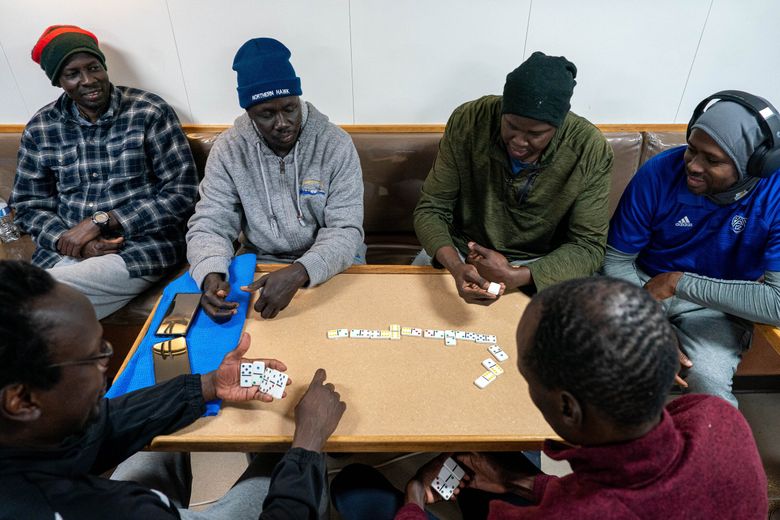
This work can cause cramps, sprains and injuries that wear down bodies. The fillet machines are plastered with danger signs and illustrations warning of other risks — severed fingers.
Most crew members are veterans like Sanogo, who has spent 19 years aboard the Northern Hawk. They typically earn $45,000 to $65,000 if they work both the winter and summer seasons.
The crew sleeps in cabins, most of which have two to four bunks. Food is welcome fuel for the work to be done. Four cooks offer galley fare that includes specialties such as African-themed spinach, peanut butter and beef dish called saka-saka. They serve daily entrees of fresh-caught flaky white fillets of pollock in numerous incarnations — fried, poached, Cajun-style and dusted with panko breadcrumbs.
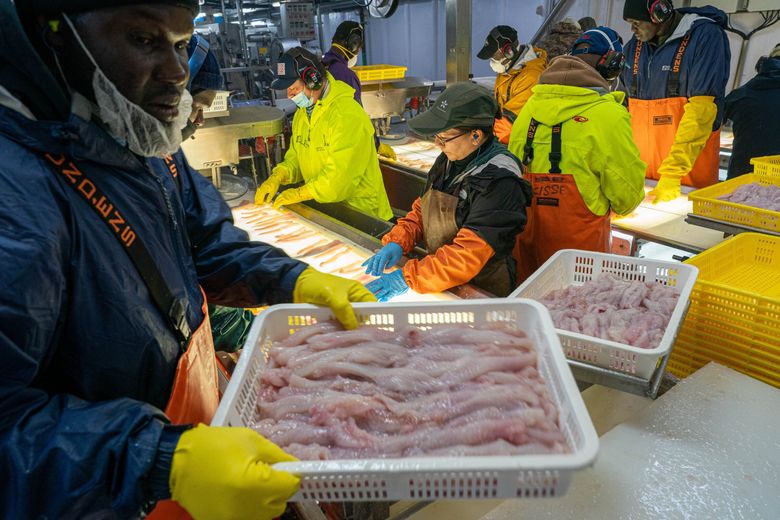
Some who have worked on other vessels prefer the Northern Hawk, where they say the crew is more close-knit, and you don’t have to worry about your cellphone or other gear getting stolen.
A few have found romance on the boat.
Maria McKenzie, one of nine women who crewed aboard the Northern Hawk this summer, works the day shift watchdogging the quality of the surimi production. She is married to Ruben Zuniga, a technician who takes care of five fillet machines, adjusting the knives as batches of pollock flow through to try to get the biggest fillet possible from each fish.
While the Northern Hawk was berthed in Seattle in 2014, they went to a soccer game together. They started dating and got married in Cancún, Mexico, in 2017 in a wedding that drew some 20 other crew members. Offseason, they live in California, where they are renovating an old Greyhound bus.
“I like it here. It’s like a family. I’m going to finish my last days of work. I’m 55, then hopefully by 62 I’m going to travel … with my husband and see the world,” McKenzie said.
Through the years, Coastal Villages management has made repeated efforts to recruit Kuskokwim villagers to work aboard the Northern Hawk and other Bering Sea vessels owned by the group.
Two men gained steady work aboard a Coastal Villages crab boat. They are considered skilled crew who “are always welcome back,” according to Deakin.
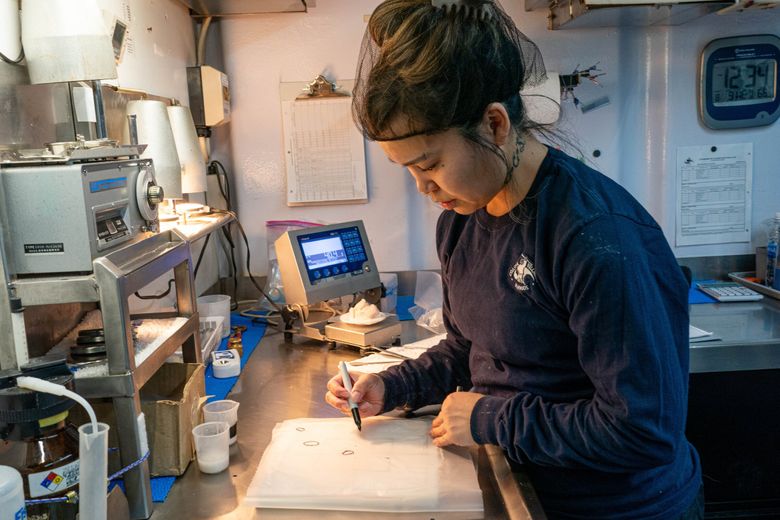
Aboard the Northern Hawk, Bonnie Bell, a longtime resident of Chevak who recently moved to Anchorage, works in a small laboratory off the surimi plant. She was first employed as a processor in 2013. She then returned in 2019 and was trained for a higher-paid position checking surimi for bacteria and doing product quality tests.
“I needed a job. I had two kids,” Bell said.
But for the most part, Coastal Villages management has found life aboard a trawler to be a tough sell to western Alaska residents.
“We did push it for a long time that we were trying to get people from our villages to work out there. It didn’t work out too well. And then during COVID, we dropped it, talking about doing that again,” said Richard Jung, a Coastal Villages board member.
To help kindle interest, Coastal Villages now offers a maritime skills training program for youth.
“I’d love to see everybody on the boat come from our region, you know, all the way from the captain down to the lowest person on the boat. … But it’s something that not everyone can do.”
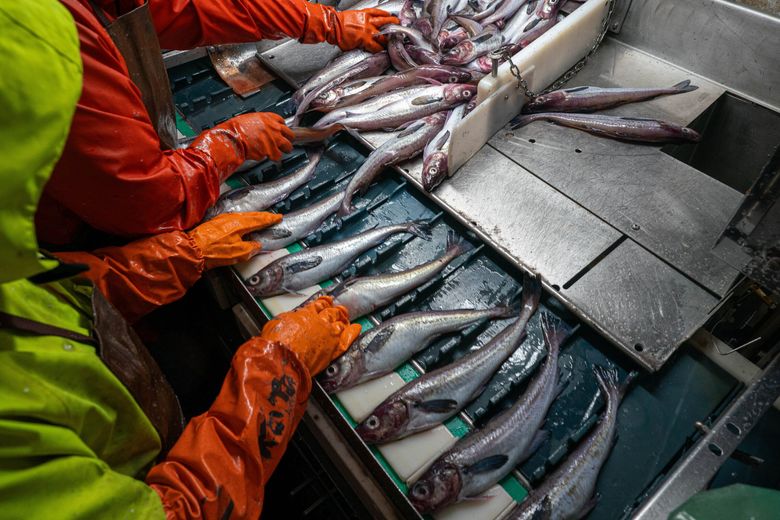
Squeezing value out of leftovers
The Northern Hawk processing lines produce enormous volumes of leftovers — heads, skin, bones and guts. These also have value.
The fats liquefy as they are heated. They then go through a decanting to produce an oil marketed as an additive for livestock feed. Other remains are dried to produce a fish meal.
This effort to squeeze the most value out of each fish is a big change from the 1980s when U.S. trawlers first entered this fishery off Alaska.
Back then, it was a race for the fish. Each trawler pushed to catch as much pollock as possible before federal managers closed the season.
In these derbies, some operators, to maximize their profits, sometimes just keep the roe, which fetched the highest prices in Asia. They didn’t want to spend the time salvaging lower-value fillets from pollock. So they jettisoned carcasses filled with flesh, which floated in long, decaying slicks behind the vessels.
“I wish I wasn’t part of that, but I was. That’s my darker days,” said Egaas, who began his career on one of the early U.S. factory vessels. “Even though I was making lots of money, I didn’t like it.”
The roe stripping was a stark example of waste in the trawl industry. It took place at a time of broad unease about the sustainability of the pollock fishery.
In the mid-20th century, foreign fleets — largely from Japan and Russia — fished off Alaska shores and caught large volumes of pollock. They eventually were pushed out of these harvests by congressional passage of a landmark 1976 law that sought to curb overharvesting and gave U.S. fishers first claim to harvests within a 200-mile zone off the nation’s coastlines.
“The concept is shall the living resource of the sea have a chance to survive,” Alaska Sen. Ted Stevens said in a speech to the Senate. “The pollock is the basic food chain for the Bering Sea and the North Pacific.”
But so long as U.S. trawlers competed against one another for pollock, the biggest profits were made by rushing to catch fish as quickly as possible, not taking the time to make the best use of each fish that came on board.
In 1995, even after roe-stripping was banned, almost 100,000 metric tons of pollock — more than 7% of the total catch — was discarded overboard, according to National Marine Fisheries Service statistics.
Factory trawlers and shore-side processors, served by smaller catcher boats, were bitter rivals for pollock and could not agree on a plan to end the derbies.
Then in 1998, Stevens and his Republican colleague Washington Sen. Slade Gorton helped forge a congressional compromise. This legislation limited the size of the fleet and ushered in a new era of slower-paced fishing where quotas are assigned to each vessel and catch information is freely shared through cooperatives, with harvests and bycatch tracked by federally contracted observers.
The fish are caught with pelagic trawls, which culminate in a tightly stitched section known as the cod end.
On a website posting, the At-Sea Processors Association calls these “midwater nets” that are not dragged along the ocean bottom.
But the nets have a colossal mouth rimmed along the lower edge by chains known as footropes. On many tows, the footrope makes contact with the bottom as skippers pursue pollock. Alaska Pacific University researchers, based on surveys of industry officials and analysis of tow data, estimated the footropes touch more than 70% of the seafloor passing below the factory trawler nets.
Egaas acknowledges that sometimes the net is “tickling the bottom” to get the fish. On some trips, he said, that may happen 70% of the time, others much less. Design improvements give the chain a lighter touch than in years past, Egaas said.
For crabbers, the unseen impacts of the footropes on sea bottom life are a source of consternation. They fear that pollock trawling may impede the recovery of snow and king crab populations and the rebound of commercial harvests. They are frustrated that federal regulators have not restricted the trawl fleet’s winter-spring access to a nearly 4,000-square-mile zone where red king crab can be found.
“We need to find a way to harvest pollock that is not harming crab,” said Jamie Goen of the Alaska Bering Sea Crabbers. “We are particularly concerned about protecting crab that are molting or mating.”
Researchers say more studies are needed to assess the risks posed by the nets.
“It’s unclear what is the survivability of crab that come into contact with the pollock trawl footrope,” said Craig Rose, a fisheries biologist who has studied trawl nets.
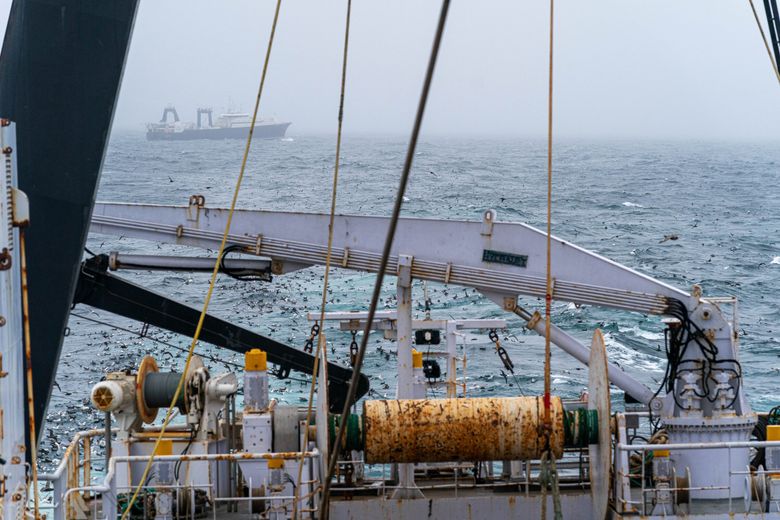
A changing ocean
The bleak years for crabbers have come at a time when trawlers have benefited from strong populations of Bering Sea pollock. The 2023 harvest quota of 1.3 million is 40% higher than in 2010 when pollock stocks were at a low point.
But the world’s great fisheries are full of stories of boom and bust, and there are no assurances that the pollock stocks will continue to thrive.
One big wild card is climate change, which has intensified concerns about the consequences of such a large-scale fishery on the broader ecosystem, including fur seals that gather to mate on the Pribilof Islands and have been in long-term decline.
During the Bering Sea warming that peaked in 2019, winter sea ice was greatly diminished and summer bottom temperatures, in some spots, measured 12 degrees Fahrenheit higher than nine years earlier.
As temperatures climbed, the pollock were on the move, migrating north as well as west toward the maritime boundary with Russia, according to federal surveys. More recently, amid cooler Bering Sea temperatures, Alaska trawlers have once again found pollock — in big concentrations — farther south.
But climate scientists predict more marine heat waves of greater intensity as the accumulation of greenhouse gases from fossil fuel combustion warms the planet. They forecast the Bering Sea will be largely ice-free late this century, and some federal marine research indicates it likely will be less productive for pollock.
In the short term, pollock face increased fishing pressure on the Russian side of the Bering Sea amid a chill in relations with the U.S. that has choked off most of the cooperation on fishery research.
The Russian government raised its Bering Sea pollock allowable harvest by 9% this year to a record level — 612,000 metric tons, according to a May report in Intrafish.
The big Russian harvest pulls more fish from the sea and pushes more product into international markets, helping depress the prices paid this year to U.S. fishers.
During his August fishing trip, Egaas surveyed a wheelhouse screen with satellite imagery depicting a map of the Russian boundary waters of the Bering Sea. Dozens of black triangles represented fishing boats netting pollock.
He clicked on the triangles, and the screen displayed photos of each vessel. One was from China. Another from Japan. Most were from Russia.
“They have a lot of boats,” Egaas said. “They have some brand-new fancy ones too. They are right on the line.”
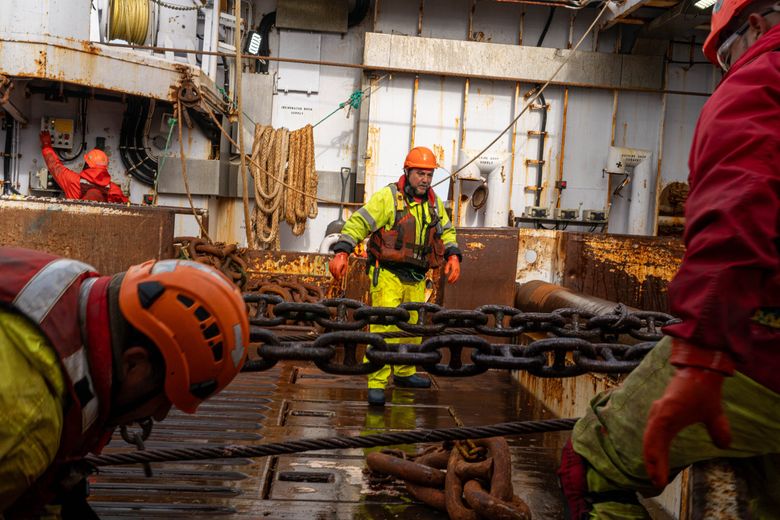
A bad night for chum
One week into the August fishing trip, Egaas got unwelcome news.
He liked to keep the chum salmon count to a half dozen, or fewer, coming up with each tow of the net.
But during a brief predawn foray into a prime pollock area — deeper water close to the edge of the Zhemchug Canyon — the Northern Hawk snared 73 chums. Other skippers fishing close by, in their radio chatter, also reported lots of chum. Some netted several hundred.
“Everyone got burned last night,” Egaas said.
Once aboard the Northern Hawk, the chum slid along with the pollock into the holding tanks. Several hours later, these fish were fed onto a conveyor at the front end of the processing plant, where a crewman pulled the salmon off the line.
Under federal regulations, there are two options for dealing with these trawl-caught salmon.
The crew can dump them overboard or donate them to a nonprofit called SeaShare, which is supported in part by grants from the pollock industry and is authorized to distribute these fish for free to food banks in Washington and Alaska.
Federal regulations require this donated salmon to be headed and gutted — not filleted. That task is typically done by a knife-wielding crew member. The fish are then frozen, offloaded in Dutch Harbor and shipped to donation sites.
SeaShare executive director Jim Harmon told the Anchorage Daily News that the organization welcomes both Chinook and chum.
“I have been doing this for 20 years, working with all the boats. We have never said no to chums. They are definitely acceptable,” Harmon said.
But that message does not appear to have made it to the whole fleet.
Northern Hawk factory manager Terje Gjerde said there was miscommunication. He said he understood that SeaShare in recent years took only Chinook. During the August pollock trip, all the chum, after being checked by observers, were put in a chute that washed the carcasses back to the sea.
Such chum discards in recent years have been a common pollock industry practice.
In 2021 and 2022, the Bering Sea fleet caught nearly 2 million pounds of chum. More than 70% of that fish never made it to SeaShare for charity distributions, according to an Anchorage Daily News analysis of average National Marine Fisheries Service weights of the chum for those two years and SeaShare reports of headed and gutted Chinook and chum donations.
Egaas and other captains are eager to find a way to keep these chum from coming on board. Net innovators have stepped up efforts to find ways to make that happen.
Bering Sea pollock trawl nets have a kind of trapdoor cut in a portion of the mesh. A light shines by this hole to try to attract salmon and guide them to freedom.
Some salmon find the hole. Many do not.
The recent addition of video cameras to the nets has prompted Rose, the veteran researcher, to come up with improvements.
Aboard the factory trawler Island Enterprise in August, he tested a device that a skipper could trigger when the camera showed salmon coming into the net. It would drop a kind of ramp that would actively herd any fish in the net to a hole that leads to safety. Then, when the salmon were no longer visible in the video, the ramp would lift back up and the hole would close.
“We did have it moving back and forth — and doing the things we want. There are still some things to be worked on,” said Rose, who estimates the net device — developed with federal funds — could be ready as early as next year.
Skippers are eager for such technology. Until then, they will continue to try to dodge salmon as they fill up their nets with the Bering Sea’s pollock bounty.
During the August trip, the Northern Hawk netted the chum in an area where past years of genetic testing indicated the majority likely would be returning to Asia — not western Alaska.
Still, Egaas was spooked by the high chum count and moved the Northern Hawk farther to the northeast. He resumed his exercise regimen, pacing around the wheelhouse.
The crew once again put down a net in a muddy-bottomed area that trawlers call “the flats.”
“I’m pretty sure I’m safe up here. I hope anyway,” Egaas said.
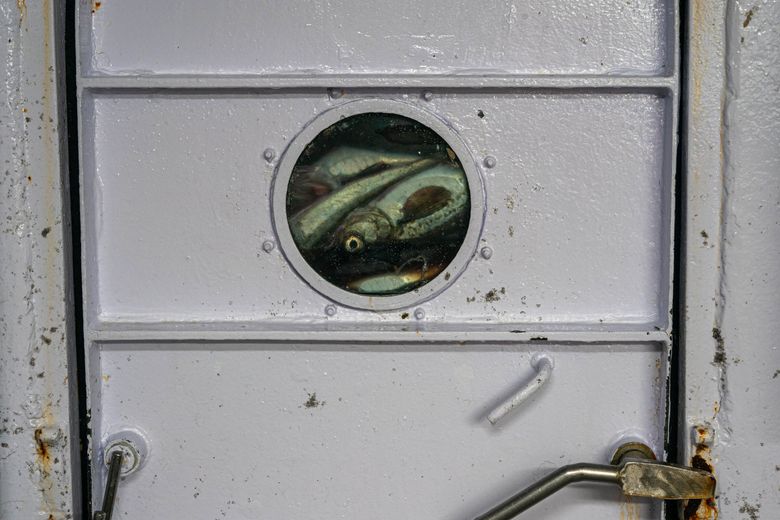
Through the course of the 2023 winter and summer seasons, the Northern Hawk caught more than 105 million pounds of pollock. The crew’s final chum tally was 743 fish.
The harvest ended on the evening of Aug. 17. Egaas blared a horn — a sweet sound that signaled to the crew that the last netload of pollock had finally come aboard.
Still, there was more work to be done.
Below deck, processors labored through the night to process this fish into frozen blocks of fillets, minced fish and surimi.
"fish" - Google News
November 01, 2023 at 08:00PM
https://ift.tt/odivcCn
Bering Sea fish bounty brings help, headaches for trawlers - The Seattle Times
"fish" - Google News
https://ift.tt/HouAEtR
https://ift.tt/fQzDjTF
Bagikan Berita Ini














0 Response to "Bering Sea fish bounty brings help, headaches for trawlers - The Seattle Times"
Post a Comment